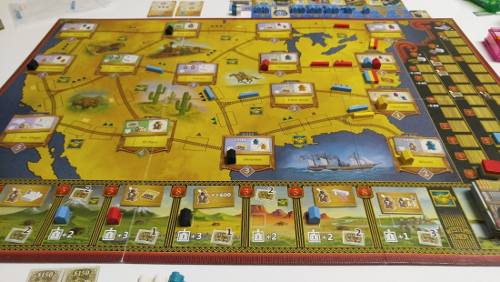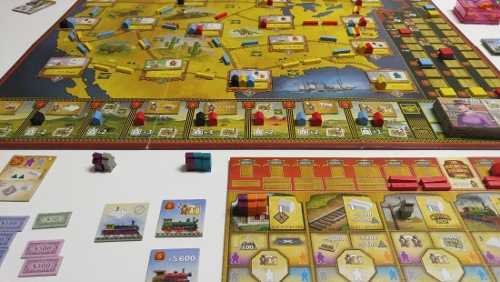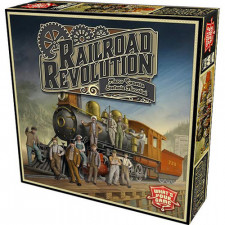Railroad Revolution Review
on May 31, 2017
One of my biggest complains about many modern Eurogames is that they often feel bloated. I can appreciate the “multiple paths to victory†design, but when you have a mishmash of progress tracks, resources, and victory points it all seems like unnecessary complexity that sucks the joy out of a game. For me, one of the biggest recent offenders of this sensibility have all been released by What's Your Game. So, it was quite a surprise that their new Railroad Revolution felt entirely different.
In Railroad Revolution, you take on the standard gaming cliché of a railroad company trying to sprawl across the United States and forge your path to glory by laying tracks and building stations. But wait, there’s more. In order to be the best little engine you can, you’ll be taking actions via specialized workers. This mechanism is singlehandedly responsible for making Railroad Revolution a much more interesting game than its muted, Instagram-filter-looking color palette wants you to believe.

The map looks like a 3rd grade geography assignment.
On your turn, you place a worker and choose an action from your player board. The actions are mostly what you’d expect in a train-themed game: lay track, build a station, build a telegraph office, or sell track/buildings for money. However, depending on the color of the worker you chose, you can take a bonus action. For example, if you use an orange worker to build a station, you can do so for free. Alternatively, had you used a gray worker, you would have received an additional bonus from the station space for building there. With four different colors of workers total, what starts as a pretty simple action selection game morphs into a combination of worker management and combo-building. Choosing the right color of worker at the right time is integral to getting to do everything you want. Because workers cannot be removed from a placed spot until your worker pool is empty, you’re in charge of your own Manifest Destiny.
Although you start out with just a handful of workers at the beginning of the game, you can acquire more through various bonuses. At first, you’re desperate to grab as many guys as you can, but eventually, you have plenty of options at your disposal. What keeps your worker pool from becoming unwieldy, however, is the fifth bonus action space under each main action: promotion. Promoting workers allows you to complete milestones, which are achievements awarding endgame points that help drive your decisions throughout the game. This pushes the game from just aimlessly connecting cities and moving up on the points-multiplier tracks to providing a direction to work towards. Once you complete a milestone, those workers are removed from your pool. It’s just like in real life when someone gets promoted and you never see them again, even though they said you could do lunch dates and it’s cool, Nancy, I get that you’re busy. Whatever. I digress.
The other cool thing about milestones is that they really cause some tension in your decisions That orange worker you were spamming to get discounts on stations being built might be the same one you need to burn in order to score the milestone. It’s a bittersweet accomplishment. And, also like the real world, once you’ve demonstrated your competence at a simple task, you get a more challenging one right after. You receive a new milestone from a higher level, which will inevitably force players to build more track and place more buildings. You will not be able to just turtle up in the starting area and churn out cheap and easy milestones.

Not pictured: the angst I’m experiencing over not being able to do everything I want to do.
Because there are no rounds, players continue taking actions until someone is down to their last few pieces of track and stations. The game is guaranteed to run itself out as players will have to sell their pieces in order to bring in cash, which is fairly tight. This helps the game to not outstay its welcome and also provide a kind of race among players. It is possible you needed just two more turns to complete a milestone, but you only end up with one more. This tension is what grabs you by the face and makes you pay attention. Altogether, this isn’t anything particularly new, but it is interesting.
For as much as Railroad Revolution might seem like it has going on, it moves surprisingly quickly and is fairly easy to jump into for experienced gamers. Because all players can always build on tracks, stations, and telegraph spots, there is no blocking. Although this does turn the game into a little bit of multiplayer solitaire, the advantage to this is that you can plan your turns in advance without worrying that someone will thwart that big move you’re going to make. This makes the game challenging without being frustrating. And the complexities come from the decisions you are making instead of the design. It may not be as exhilarating as a cross-country train ride, but it’s a decent way to spend 60-90 minutes. So, even though it’d be easy to discount Railroad Revolution on account of its plain looks, there’s a lot more personality in the box than you might think.

 Customer Support
Customer Support  Subscribe
Subscribe 




 Account
Account  Wishlist
Wishlist 

